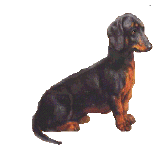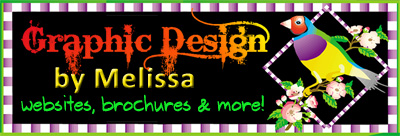
DACHSHUND COLORS BLACK/TAN (can appear in all coats): The second most familiar dachshund color. A blk/tan dachshund will be black all over with tan points (tan feet, over eyes, on face around muzzle, on chest, under tail). It will have black eyes, nose, and black nails. Blk/tan is recessive which means a blk/tan bred to a blk/tan will produce blk/tan unless they both carry the chinchilla factor which will create a recessive red puppy. BLACK (can appear in all coats): A black dachshund will be black all over without any tan points. It will have black eyes, black nose, and black nails. This is not the result of continuous breeding of black/tan to blk/tan. Black breeds true and appears to breed dominant over the black/tan. The black is simply the 'B' gene lacking the tan point gene. CHOCOLATE/TAN (can appear in all coats): A choc/tan will be from milk chocolate brown to a dark chocolate brown with tan points (tan on feet, over eyes, on face around muzzle, on chest, under tail). It will have a brown to light brown nose and nails. A true choc/tan will NEVER have a black nose. It will have brown to light brown eyes and on occasion green to hazel eyes. This is a rexessive color it must be showing or carried in both parents to appear. CHOCOLATE (can appear in all coats): A chocolate will be a dark chocolate brown all over without any tan points. It will have a brown to light brown eyes, nose, and nails. This is a recessive color it must be showing or carried in both parents to appear but breeds dominant to chocolate/tan. CREAM, American These puppies are born light and look creamy when they are 12 weeks old. As they grow older they will become red. The red can vary from a strawberry blonde to a dark red. This has confused many pet buyers and breeders into thinking they have English Cream puppies. Many pet buyers are disappointed when their beautiful cream puppies turn red as they grow older. The only way to get English Cream puppies is to have English Creams on both sides of the pedigree. CREAM, English (only applicable to long and smooth coats): The Chinchilla Dilution (“C”) gene series is responsible for true English cream. It effects the base coat color red, and the points color, tan, (i.e., the color above the eyes, along the nose, etc.). This gene does NOT affect black and chocolate pigments. So, when two alleles for the chinchilla gene are present, the red base coat is diluted to the cream color, but any black overlay is unaffected. Hence, a true English cream dachshund may have a black overlay, whereas red dilutes will not. When dominant reds are overwritten with two Chinchilla genes, true English cream puppies will be born very dark in color, almost black. However, over the course of the first 6 or 8 weeks, the true cream color emerges from the undercoat, slowly overtaking the initial black coat. The older the puppies get, the lighter in color they become. Some may lose almost all of their black overlay, while others may retain a great deal of it. The later are often called “shaded English cream”. The key to identifying these pups is evidence that they were born black and are progressing toward cream. When recessive reds are overwritten with two Chinchilla genes, true English cream puppies are born very light in color, a beautiful golden buff to near white, without any black overlay because the recessive red alleles (ee) prevent any black pigment from showing in the coat. These puppies are called “clear English cream”. “Clear” referring to their lack of any black overlay. The key to identifying these pups is evidence that they were born very light without any trace of a black overlay and continue this way. All creams will have black eyes, black nose and black nails. BLACK/CREAM (only applicable to long and smooth coats): A black and cream dachshund will be black all over with cream points (cream on fee, over eyes, on face around muzzle, on chest, under tail). It will have black eyes, black nose, and black nails. WHEATEN ( only applicable to wire coats): A wheaten will be from a platinum blonde to light red in color. It will have black eyes, black nose, and black nails. This is a recessive color it must be showing or carried in both parents to appear. BLUE/TAN (can appear in all coats): A blue and tan is a diluted black/tan. It will be a gun metal blue color with tan points. Its color should resemble a blue Doberman. It will have grey eyes, grey nose, and grey nails. This is a recessive color it must be showing or carried in both parents to appear. Be cautious buy only with a lifetime skin disorder guarantee, they have a tenency to have color mutant alopecia. ISABELLA(fawn)/TAN (can appear in all coats): An Isabella/Tan is a diluted chocolate/tan. It will appear to be a washed out chocolate and tan. Its color should resemble a Weimaraner but with tan points. It will have grey eys, grey nose and grey nails. This is a recessive colr it must be showing or carried in both parents to appear. BRINDLE (can appear in all coats): Brindling is a distinct tiger stripe pattern over the base coat color. It can appear over any color. It is dominant which means one of the parents mush show pattern for it to appear and it acn appear with piebald pattern. DAPPLE (can appear in all coats): Dappling is spotting or marbling of a lighter color mixed in with base coat color. It can appear over any color. It is dominant which means one of the parents must show pattern for it to appear and it can appear over any color. It is dominant which means one of the parents must show pattern for it to appear and it can appear with piebald pattern. Red dapple-dappling is lighter red, black/tan dapple-dappling is grey/silver, chocolate/tan dapple-dappling is eggnog colored, blue/tan dappling-dappling is diluted eggnog color. If dappling occurs in eyes, eyes will be blue (can be one or both) or have blue flecks in the. It is impossible to have blue eyes on a dachshund without the dapple pattern. DOUBLE DAPPLE (can appear in all coats): CAN ONLY OCCUR WHEN TWO DAPPLED DACHSHUNDS ARE BRED TOGETHER. A double dapple will be dappled dachshund with patches of white also mixed in. It can appear over any color, can only occur when both parents are dappled. The dapple gene is lethal in double doses, 4% of all double dapples born are blind or deaf or both. Dapple to dapple breeding should be done only with great consideration and caution by experienced breeders. Most usually the have two blue eyes but can have only one blue eye and on occasion two brown eyes. It is impossible to have blue eyes on a dachshund without the dapple pattern. A double dapple will make all dapple offspring when bred. It is often mistaken for piebald pattern. PIEBLAD-WHITE SPOTTING(can appear in all coats); There are three degrees of white spotting possible in the dachshund only two of the three degrees should be registered as piebalds. The first degree of white spotting is 'irish white spotting'. This classification would include any amount of white on a dachshund LESS than four white legs, a white tipped tail and a white chest. This minimum amount of white spotting should NOT be registered as a piebald but instead simply as the base coat color. The second degree is 'pieblad white spotting'. This classification would be the minimum amount of white being four completely white legs, a white tipped tail, and a white chest and then up to 80% of white on the coat. The third degree is 'extreme piebald white spotting'. This is where more than 80% of the coat is white. Both the second and third degrees of white spotting should be registered as piebalds. These can appear with any color. White spotting is recessive which means both parents must be showing or carrying for it to appear. It can appear with the dominant patterns brindle and dapple patterns, but be aware AKC does not register or recongnize two patterns on the dachshund. It is a safe means of creating white dachshund color, not lethal like dapple gene. (Note: Dapple piebalds often have one or two blue eyes - a solid piebald or brindle piebald will NEVER have blue eyes only brown eyes. It is impossible to have blue eyes on a dachshund without the dapple pattern). White spotting can have 'ticking' which looks like someone took a marker and put little dots of color in the white. 'Ticking' is dominant only one of the parents needs to be ticked for ticking to appear. SABLE (applicable only to long coats)/WILDBOAR(technically a color but in essence a pattern, applicable to wire and smooth coats): These terms (especially sable) are often mistakenly used to refer to an interspersion of black hairs on back and neck over red color. A true red sable/wildboar will appear to be black and tan from a distance. The undercoat beneath black being red. Sable/wildboar is a very heavy layer of black over the base coat color. This is an uncommon pattern. This is a pattern that can not be truly labeled until pup reaches 6 months of age. Many pups labeled sable/wildboar lose black overlay and become simply red with no pattern. Smooth puppies born from blk/tan and red smooths with black overlay are often mistakenly labeled sable. Reserve your puppy now - URL: http://www.ewe2you.com/doxie
 Home
Home  Puppy Gallery
Puppy Gallery  Dachshund Colors
Dachshund Colors  Housebreaking
Housebreaking  Archive
Archive
![]()
![]()
PATTERNS![]()
 Home
Home  Puppy Gallery
Puppy Gallery  Dachshund Colors
Dachshund Colors  Housebreaking
Housebreaking  Archive
Archive
contact Vom Treuen Wachter Mini Dachshunds:


Please send $50 deposit for each
reservation - mail check, M.O., or use Pay Pal (www.paypal.com)
Thank you!
